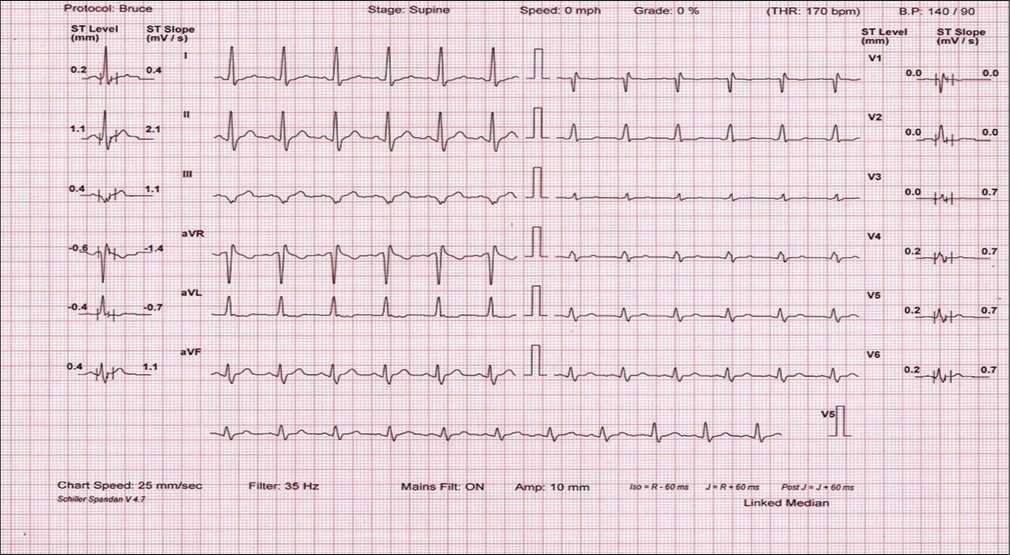Translate this page into:
Exercise-induced Brugada Type I Pattern of ECG in an Asymptomatic Adult
*Corresponding author: Sridevi Chigullapalli, Department of Cardiology, Dr. D.Y. Patil Medical College and Hospital, Pune, Maharashtra, India. csridevi2007@rediffmail.com
-
Received: ,
Accepted: ,
How to cite this article: Chigullapalli S, Malani SK, Khan A, Wadhokar PS. Exercise-induced Brugada Type I Pattern of ECG in an Asymptomatic Adult. Indian J Cardiovasc Dis Women. 2024;9:116-7. doi: 10.25259/IJCDW_38_2023
Brugada syndrome is a rare hereditary cardiac arrhythmia causing sudden cardiac death in persons with structurally normal hearts. Type 1 Brugada pattern of electrocardiogram (ECG) is seen in patients with Brugada syndrome during rest or seen after provocation with drugs such as ajmaline, procainamide, flecainide, and increased vagal tone or during fever.[1] Adrenergic stimulation with exercise and isoprenaline decreases the elevation of ST segment.[2] Here, we present an ECG image of a patient who developed type I Brugada ECG pattern (right bundle branch block [RBBB], ST elevation with T inversion in V1) during routine stress test which is done for annual health checkup [Figures 1 and 2]. Only few case reports are available which showed exercise-induced type I Brugada pattern.[3] RBBB during exercise can occur rarely as a benign finding in which ST depression is seen V1 and V2 (Lead V1 and Lead V2). RBBB can be rarely due to ischemia during exercise and it is characterized by Q right bundle branch block (RBBB) with ST elevation in V1, V2 and ST depression in V5, V6. In our patient, RBBB with ST elevation in V1 is seen with no ST depression in V5, V6 (Lead V5 and Lead V6).

- Resting ECG showing incomplete RBBB. (ECG: Electrocardiogram, RBBB: Right bundle branch block.)

- ECG during peak exercise showing complete RBBB, ST elevation, and T inversion in V1. (ECG: Electrocardiogram, RBBB: Right bundle branch block, V1: LEAD V1)
Ethical approval
Institutional Review Board approval is not required.
Declaration of patient consent
The authors certify that they have obtained all appropriate patient consent.
Conflicts of interest
Dr. C Sridevi is on the editorial board of Journal.
Use of artificial intelligence (AI)-assisted technology for manuscript preparation
The authors confirm that there was no use of artificial intelligence (AI)-assisted technology for assisting in the writing or editing of the manuscript and no images were manipulated using AI.
Financial support and sponsorship
Nil.
References
- Idiopathic Ventricular Fibrillation Induced with Vagal Activity in Patients without Obvious Heart Disease. Circulation. 1997;95:2275-85.
- [CrossRef] [PubMed] [Google Scholar]
- Autonomous and Antiarrhythmic Modulation of ST Segment Elevation in Patients with Brugada Syndrome. J Am Coll Cardiol. 1996;27:1061-70.
- [CrossRef] [PubMed] [Google Scholar]
- An Unusual Case of Exercise Induced Idiopathic Brugada Electrocardiographic Pattern. Korea Cir J. 2007;37:517-9.
- [CrossRef] [Google Scholar]







